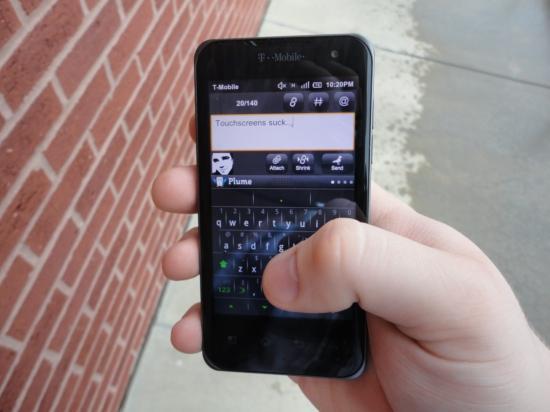
One of the biggest gripes that has come of the modern smartphone is the frustration surrounding text input. In an effort to slim down, lighten and optimize the touchscreen slabs for mobile platforms, manufacturers have started transitioning away from physical keyboards in favor of larger displays. As a result, we are left typing on tactile-less, alienating software keyboards.
Some people like the creators of Swype, FlexT9 and SwiftKey have done their best to relieve the strain and frustration by reducing the necessary keystrokes and taps needed when typing a word. OEMs have also enabled haptic feedback to try to simulate the tactile feedback of a physical keyboard. And even KDDI, the second largest carrier in Japan, has set out to solve the woes of smartphones users left with tactile-less displays by attempting to recreate the actual feedback given by a physical button.
Despite all of these endeavors to make typing on a touchscreen less stressing and more user-friendly, none of them truly make things easier across the board. They may make one aspect of touchscreen typing better, but every software keyboard to date is a generic shape and size, which doesn't accommodate for different typing styles and hand sizes.
IBM, on the other hand, seeks to solve that problem. Earlier this morning, TechCrunch (TC) revealed that IBM has applied for a patent that “points to an on-screen keyboard that matches the user’s anatomy, changing to reflect each users 'unique typing motion.'” Users will go through a series of calibration exercises that will adjust the keyboard to actually fit the user's hand. It tests variables like “finger skin touch area, finger size data and finger position,” according to John Biggs of TC. Biggs goes on to say that some individual buttons on the keyboard will be bigger than others and possibly in different locations. This approach only makes sense seeing as no two hands are alike (excluding identical twins, of course).
This sounds familiar to one elusive software keyboard that users have been (im)patiently awaiting for some time now, BlindType. Instead of calibration tests and judging different the several different factors, however, BlindType adjusts to the user's typing style – rotating, resizing and relocating – on the fly. As shown in a demonstration video, the need to look while typing on a touchscreen will likely be a thing of the past. But don't ask me how BlindType works, their black magic leaves me dumbfounded. Now owned by Google (acquired back in October of 2010), BlindType will appear on Android handsets sometime in future – we hope for an appearance sooner rather than later. Ice Cream Sandwich, maybe?
Being a former BlackBerry fanboy, it has been a hard transition from some of the most exquisite portable QWERTYs to their not-so-friendly software counterparts. The more I use Swype, the more I hate it. SwiftKey has served me well for several months. But as per usual, when I get comfortable with a software keyboard, I become lazy and begin to misspell words and take shortcuts.
I don't know about you guys, but I'm ready for some of this innovative touch input software to finally grace my fingertips. With IBM, Google and a plethora of third-party developers working on some impressive software, it's only a matter of time before the woes of touchscreen texters are resolved ... I hope.